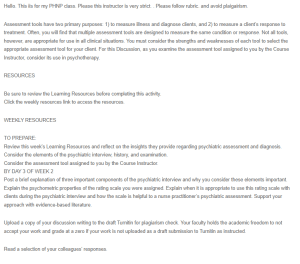Enhancing Psychiatric Assessment in Older Adults – Integrating Cognitive and Mood Evaluation Tools
Response to Tera Olivi
Hello,
I agree that building a trusting relationship with the patient is crucial in psychiatric interviews, especially when dealing with vulnerable populations like older adults. Trust facilitates great interaction, hence improved diagnosis because patients are more willing to reveal their condition. Indeed, your elaboration on the possible implementation of the Geriatric Depression Scale (GDS) in identifying depression in elderly patients highlights the value of this instrument in the management of elderly patients. Nonetheless, since GDS is more suitable for older adults, its comparison to more extensive inventories such as BDI-II, whose utilization is more common in younger people because it examines a wider range of the symptoms, turns out to be quite efficient (Henriques et al., 2023).
One of the potential weaknesses of GDS is that it assesses emotional complaints rather than cognitive or somatic symptoms, which might be prevalent in some elderly patients (AlRuthia et al., 2020). In your opinion, does the integration of GDS in the evaluation process together with tools such as the PHQ-9, offer a better perspective of the mental health of an elderly patient? One might wonder whether integrating scales could provide better care outcomes.
References
AlRuthia, Y., Alwhaibi, M., Almalag, H., Almosabhi, L., Almuhaya, M., Sales, I., Albassam, A. A., Alharbi, F. A., Mansy, W., Bashatah, A. S., & Asiri, Y. (2020). The relationship between trust in primary healthcare providers among patients with diabetes and levels of depression and anxiety. PloS One, 15(9), e0239035. https://doi.org/10.1371/journal.pone.0239035
Henriques, S., Pérez‐Sáez, E., Carvalho, J. O., Elzbieta Bobrowicz-Campos, João Apóstolo, Otero, P., & Vázquez, F. (2023). Reliability and validity of the geriatric depression scale in a sample of Portuguese older adults with mild-to-moderate cognitive impairment. Brain Sciences, 13(8), 1160–1160. https://doi.org/10.3390/brainsci13081160
Response to Kulbinder Hans
Hello,
This is a great post. It provides a comprehensive overview of the importance of the Mini-Mental State Examination (MMSE) in cognitive assessments. I appreciate how you highlighted its role in tracking cognitive changes over time, making it invaluable for diagnosing and monitoring conditions like dementia. However, as you mentioned, the MMSE lacks questions related to psychiatric disorders, which may limit its use in more holistic psychiatric evaluations. Comparing this to the Beck Depression Inventory-II (BDI-II), which focuses on mood disorders, one can see how different tools serve distinct purposes in psychiatric practice (Noetel et al., 2024). For instance, combining the use of the MMSE and the BDI-II might present a more comprehensive assessment of a patient’s cognitive and emotional status. Still, how might these tools be used together in approaching psychiatric evaluations in patients with dual diagnoses of depression and dementia? An approach such as this could assist NPs with not only target mood issues but also cognitive issues, thus enhancing the quality of care (Wang & Gorenstein, 2019).
References
Noetel, M., Sanders, T., Gallardo-Gómez, D., Taylor, P., Cruz, B. del P., Hoek, D. van den, Smith, J. J., Mahoney, J., Spathis, J., Moresi, M., Pagano, R., Pagano, L., Vasconcellos, R., Arnott, H., Varley, B., Parker, P., Biddle, S., & Lonsdale, C. (2024). Effect of exercise for depression: Systematic review and network meta-analysis of randomized controlled trials. BMJ, 384(8417), e075847. https://doi.org/10.1136/bmj-2023-075847
Wang, Y.-P., & Gorenstein, C. (2019). Assessment of depression in medical patients: A systematic review of the utility of the Beck Depression Inventory-II. Clinics, 68(9), 1274–1287. https://doi.org/10.6061/clinics/2013(09)15
ORDER A PLAGIARISM-FREE PAPER HERE
We’ll write everything from scratch
Question
Hello. This iis for my PHNP class. Please this instructor is very strict. . Please follow rubric. and avoid plaigairism.
Assessment tools have two primary purposes: 1) to measure illness and diagnose clients, and 2) to measure a client’s response to treatment. Often, you will find that multiple assessment tools are designed to measure the same condition or response. Not all tools, however, are appropriate for use in all clinical situations. You must consider the strengths and weaknesses of each tool to select the appropriate assessment tool for your client. For this Discussion, as you examine the assessment tool assigned to you by the Course Instructor, consider its use in psychotherapy.

Enhancing Psychiatric Assessment in Older Adults
RESOURCES
Be sure to review the Learning Resources before completing this activity.
Click the weekly resources link to access the resources.
WEEKLY RESOURCES
TO PREPARE:
Review this week’s Learning Resources and reflect on the insights they provide regarding psychiatric assessment and diagnosis.
Consider the elements of the psychiatric interview, history, and examination.
Consider the assessment tool assigned to you by the Course Instructor.
BY DAY 3 OF WEEK 2
Post a brief explanation of three important components of the psychiatric interview and why you consider these elements important. Explain the psychometric properties of the rating scale you were assigned. Explain when it is appropriate to use this rating scale with clients during the psychiatric interview and how the scale is helpful to a nurse practitioner’s psychiatric assessment. Support your approach with evidence-based literature.
Upload a copy of your discussion writing to the draft Turnitin for plagiarism check. Your faculty holds the academic freedom to not accept your work and grade at a zero if your work is not uploaded as a draft submission to Turnitin as instructed.
Read a selection of your colleagues’ responses.
BY DAY 6 OF WEEK 2
Respond to at least two of your colleagues on 2 different days by comparing your assessment tool to theirs.
Note: For this Discussion, you are required to complete your initial post before you will be able to view and respond to your colleagues’ postings. Begin by clicking on the “Post to Discussion Question” link, and then select “Create Thread” to complete your initial post. Remember, once you click on Submit, you cannot delete or edit your own posts, and you cannot post anonymously. Please check your post carefully before clicking on Submit!

